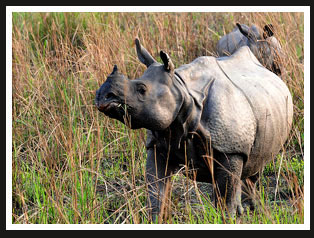Indian Rhino

Indian Rhino
Indian Rhinoceros is silver brown in colour and has folds all over its body. Both male and female rhinoceros have one horn. Males weigh around 2200 kg while the females weigh around 1600 kg. Male rhino is 1.8 m tall while the females are 1.6 m tall. They do not have hairs on their body. Their horn is 20 -61 cm long. It has well developed incisor teeth and two long canine teeth in its lower jaw. They have poor eyesight.
Rhinos have a very thick coat, which is silver-brown in color and have the minimal of body hair. The shoulders as well as the upper part of the legs have wart-like bumps throughout. Male rhinos are larger than the females, with their weight being somewhere around 2260 to 3000 kg. The average height of an Indian rhinoceros is 1.70 m (5.7 feet) and its average length hovers around 3.50 m (11.7 feet). As the name suggests, the Great One-Horned Rhinoceros has a single horn, which grows to a length of 20 to 101 cm. It is present in both males as well as females and starts growing around 6 years after birth.
Natural Habitat
The Great Indian rhinoceros is usually found inhabiting the tall grasslands and forests in the foothills of the Himalayas. Presently, it is found only in India (Assam) and Nepal.
Behavior
Indian Rhino is basically a lonely and solitary creature and can be seldom found forming groups. The only exception to this behavior consists of groups of mothers and calves and breeding pairs. A male rhino of India usually has a home range, within which it lives. The range usually stretches from 2 to 8 sq km and may overlap with that of some other male.
During mating season, dominant males will not tolerate any other male crossing their territory. If such a thing happens, dangerous fights are bound to ensue. Indian rhinoceros are mainly diurnal creatures and are quite active during the day. During daytime, you can spot them wallowing in lakes, rivers, ponds, and puddles. Through this process, they try to cool themselves.
BOOK NOW
Diet
The Great Indian Rhinoceros is herbivorous. Its diet mainly consists of grasses, leaves, aquatic plants and fruits.
Conservation status
Endangered species
Lifespan
Lifespan of the Indian Rhinos is about 47 years.
Found In
Kaziranga National Park and Bandhavgarh National Park in India


